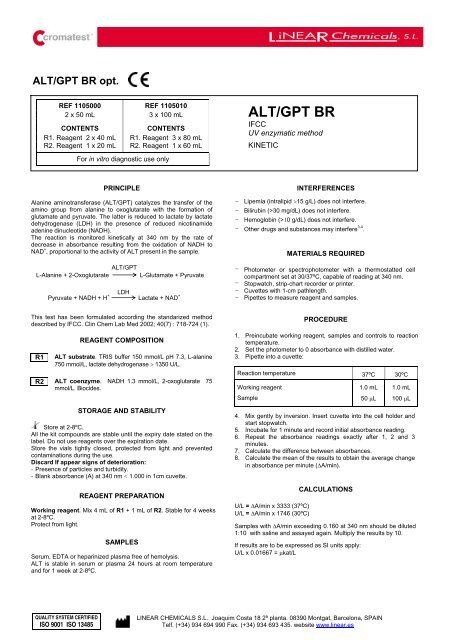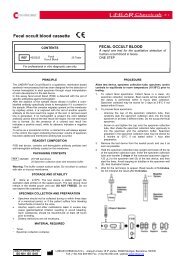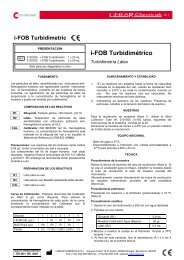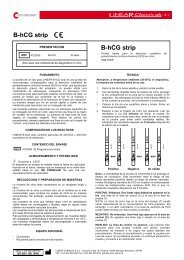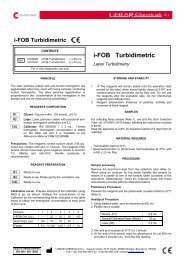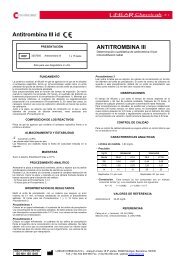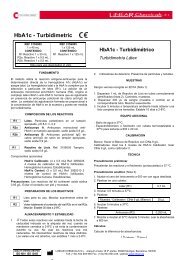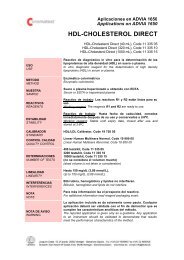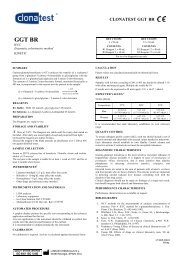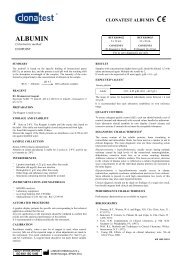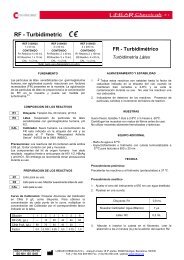ALT/GPT BR - LINEAR CHEMICALS
ALT/GPT BR - LINEAR CHEMICALS
ALT/GPT BR - LINEAR CHEMICALS
You also want an ePaper? Increase the reach of your titles
YUMPU automatically turns print PDFs into web optimized ePapers that Google loves.
<strong>ALT</strong>/<strong>GPT</strong> <strong>BR</strong> opt.REF 1105000 REF 11050102 x 50 mL 3 x 100 mLCONTENTSCONTENTSR1. Reagent 2 x 40 mL R1. Reagent 3 x 80 mLR2. Reagent 1 x 20 mL R2. Reagent 1 x 60 mLFor in vitro diagnostic use only<strong>ALT</strong>/<strong>GPT</strong> <strong>BR</strong>IFCCUV enzymatic methodKINETICPRINCIPLEAlanine aminotransferase (<strong>ALT</strong>/<strong>GPT</strong>) catalyzes the transfer of theamino group from alanine to oxoglutarate with the formation ofglutamate and pyruvate. The latter is reduced to lactate by lactatedehydrogenase (LDH) in the presence of reduced nicotinamideadenine dinucleotide (NADH).The reaction is monitored kinetically at 340 nm by the rate ofdecrease in absorbance resulting from the oxidation of NADH toNAD + , proportional to the activity of <strong>ALT</strong> present in the sample.−−−−INTERFERENCESLipemia (intralipid >15 g/L) does not interfere.Bilirubin (>30 mg/dL) does not interfere.Hemoglobin (>10 g/dL) does not interfere.Other drugs and substances may interfere 3,4 .MATERIALS REQUIRED<strong>ALT</strong>/<strong>GPT</strong>L-Alanine + 2-OxoglutarateL-Glutamate + PyruvateLDHPyruvate + NADH + H + Lactate + NAD +−−−−Photometer or spectrophotometer with a thermostatted cellcompartment set at 30/37ºC, capable of reading at 340 nm.Stopwatch, strip-chart recorder or printer.Cuvettes with 1-cm pathlength.Pipettes to measure reagent and samples.This test has been formulated according the standarized methoddescribed by IFCC. Clin Chem Lab Med 2002; 40(7) : 718-724 (1).R1REAGENT COMPOSITION<strong>ALT</strong> substrate. TRIS buffer 150 mmol/L pH 7.3, L-alanine750 mmol/L, lactate dehydrogenase > 1350 U/L.R2 <strong>ALT</strong> coenzyme. NADH 1.3 mmol/L, 2-oxoglutarate 75mmol/L. Biocides.STORAGE AND STABILITYStore at 2-8ºC.All the kit compounds are stable until the expiry date stated on thelabel. Do not use reagents over the expiration date.Store the vials tightly closed, protected from light and preventedcontaminations during the use.Discard If appear signs of deterioration:- Presence of particles and turbidity.- Blank absorbance (A) at 340 nm < 1.000 in 1cm cuvette.REAGENT PREPARATIONWorking reagent. Mix 4 mL of R1 + 1 mL of R2. Stable for 4 weeksat 2-8ºC.Protect from light.SAMPLESSerum, EDTA or heparinized plasma free of hemolysis.<strong>ALT</strong> is stable in serum or plasma 24 hours at room temperatureand for 1 week at 2-8ºC.1.2.3.PROCEDUREPreincubate working reagent, samples and controls to reactiontemperature.Set the photometer to 0 absorbance with distilled water.Pipette into a cuvette:Reaction temperature 37ºC 30ºCWorking reagentSample4.5.6.7.8.1.0 mL50 μL1.0 mL100 μLMix gently by inversion. Insert cuvette into the cell holder andstart stopwatch.Incubate for 1 minute and record initial absorbance reading.Repeat the absorbance readings exactly after 1, 2 and 3minutes.Calculate the difference between absorbances.Calculate the mean of the results to obtain the average changein absorbance per minute (ΔA/min).U/L = ΔA/min x 3333 (37ºC)U/L = ΔA/min x 1746 (30ºC)CALCULATIONSSamples with ΔA/min exceeding 0.160 at 340 nm should be diluted1:10 with saline and assayed again. Multiply the results by 10.If results are to be expressed as SI units apply:U/L x 0.01667 = μkat/LQUALITY SYSTEM CERTIFIEDISO 9001 ISO 13485<strong>LINEAR</strong> <strong>CHEMICALS</strong> S.L. Joaquim Costa 18 2ª planta. 08390 Montgat, Barcelona, SPAINTelf. (+34) 934 694 990 Fax. (+34) 934 693 435. website www.linear.es
Serum, plasmaAdultsREFERENCE VALUES 437ºC up to 40 U/L (0.67 μkat/L)30ºC up to 25 U/L (0.42 μkat/L)Levels approximately twice the adult level are seen in neonates andinfants; these decline to adult level by approximately 6 months of age.It is recommended that each laboratory establishes its ownreference range.QUALITY CONTROLTo ensure adequate quality control (QC), each run should include aset of controls (normal and abnormal) with assayed values handledas unknowns.REF1980005 HUMAN MULTISERA NORMALBorderline level of <strong>ALT</strong>. Assayed.REF 1985005 HUMAN MULTISERA ABNORMALElevated level of <strong>ALT</strong>. Assayed.If the values are found outside of the defined range, check theinstrument, reagents and procedure.Each laboratory should establish its own Quality Control schemeand corrective actions if controls do not meet the acceptabletolerances.NOTES1. This method may be used with different instruments. Anyapplication to an instrument should be validated to demonstratethat results meets the performance characteristics of themethod. It is recommended to validate periodically theinstrument. Contact to the distributor for any question on theapplication method.2. Clinical diagnosis should not be made on findings of a single testresult, but should integrate both clinical and laboratory data.1.2.3.4.REFERENCESWinn-Deen E S, David H, Sigler G, and Chavez R. Clin Chem1988;34:2005.International Federation of Clinical Chemistry (IFCC). ClinChem Lab Med 1998;36:185.Young DS. Effects of drugs on clinical laboratory tests, 5thed. AACC Press, 2000.Tietz. Textbook of Clinical Chemistr, 2 rnd Edition. Burtis CA,Ashwood ER. W.B. Saunders Co. 1994.CLINICAL SIGNIFICANCEThe group of enzymes called transaminase exist in tissues of manyorgans. Necrotic activity in these organs causes a release ofabnormal quantities of enzyme into the blood where they aremeasured.Since heart tissue is rich in AST increased serum levels appear inpatients after myocardial infarction, as well as in patients withmuscle disease, muscular dystrophy and dermatomyositis.The liver is specially rich in <strong>ALT</strong>, being the enzyme measurementused primarily as a test for infectious and toxic hepatitis, althoughhigh levels of both <strong>ALT</strong> and AST may also be found in cases of livercell damage and acute pancreatitis, suggesting that the obstructionof the biliary tree by the edematous pancreas and the presence ofassociate hepatic disease may contribute to elevated AST levels inthese patients.Slight or moderate elevations of AST and <strong>ALT</strong> activities may beobserved after intake of alcohol and after administration of variousdrugs, such as salicylates, opiates and ampicillin.ANALYTICAL PERFORMANCE- Detection Limit : 7.95 U/L- Linearity : Up to 500 U/L- Precision:U/L Within-run Between-runMean 32.4 140.8 32.4 140.8SD 0.79 1.41 0.97 2.77CV% 2.43 1.00 3.49 1.97N 10 10 10 10- Sensitivity : 0.280 mA / min/ U/L <strong>GPT</strong>.- Correlation: This assay (y) was compared with a similar commercialmethod (x). The results were:N = 50 r = 0.99 y = 1.041x + 1.447The analytical performances have been generated using onautomatic instrument. Results may vary depending on theinstrument.B1105-2/0901R1.ingQUALITY SYSTEM CERTIFIEDISO 9001 ISO 13485<strong>LINEAR</strong> <strong>CHEMICALS</strong> S.L. Joaquim Costa 18 2ª planta. 08390 Montgat, Barcelona, SPAINTelf. (+34) 934 694 990 Fax. (+34) 934 693 435. website www.linear.es


